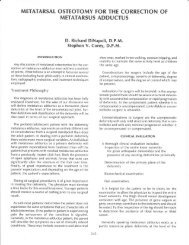anatomic approach to preparation and fusion of the interphalangeal ...
anatomic approach to preparation and fusion of the interphalangeal ...
anatomic approach to preparation and fusion of the interphalangeal ...
Create successful ePaper yourself
Turn your PDF publications into a flip-book with our unique Google optimized e-Paper software.
56CHAPTER 12Figure 14. The con<strong>to</strong>ured cup <strong>and</strong> dome fit.addition, <strong>the</strong> rongeur instrument will <strong>of</strong>ten result inincomplete cartilage removal on <strong>the</strong> middle phalanx, afunction <strong>of</strong> <strong>the</strong> mismatch between <strong>the</strong> phalangeal surface<strong>and</strong> <strong>the</strong> tip <strong>of</strong> <strong>the</strong> instrument. This incomplete tissue removalwill lead <strong>to</strong> osseous union problems.ANATOMIC APPROACHTO JOINT RESECTIONJoint <strong>preparation</strong> is very tedious <strong>and</strong> more <strong>of</strong>ten than notimperfect. The ideal operation would be a rapid jointdisarticulation, rapid <strong>and</strong> precise cartilage removal as withh<strong>and</strong> instruments without excessive s<strong>of</strong>t tissue disruption orheat generation seen with powered instruments, <strong>and</strong> perfectapproximation <strong>of</strong> <strong>the</strong> bone ends after cartilage removal.These fac<strong>to</strong>rs led <strong>to</strong> <strong>the</strong> development <strong>of</strong> a micro-reamingsystem, one that combines <strong>the</strong> precision <strong>and</strong> control <strong>of</strong> h<strong>and</strong>instrumentation with <strong>the</strong> rapid tissue removal <strong>of</strong> a poweredinstrument (Figures 16, 17). The instruments reducedoperating time, completely <strong>and</strong> uniformly removed articulartissue, increased surface area <strong>of</strong> <strong>the</strong> <strong>fusion</strong> mass, <strong>and</strong> reduce<strong>to</strong>tal bone loss. The corresponding reamers attach <strong>to</strong>st<strong>and</strong>ard Kirschner wire (K-wire) drivers which run atvariable speeds, a function that allows for slow or rapidremoval <strong>of</strong> bone tissue (Figures 18, 19). The devices have aclosed periphery, preventing additional s<strong>of</strong>t tissue damageby enclosing <strong>the</strong> cutting device <strong>and</strong> restricting tissue removal<strong>to</strong> <strong>the</strong> area within a dome. The amount <strong>of</strong> bone removedcan be finely adjusted by <strong>the</strong> number <strong>of</strong> revolutions <strong>of</strong> <strong>the</strong>cutter on <strong>the</strong> bone, a function <strong>of</strong> two variables directlycontrolled by <strong>the</strong> surgeon: <strong>the</strong> speed <strong>of</strong> <strong>the</strong> drill <strong>and</strong> <strong>the</strong>pressure delivered <strong>to</strong> <strong>the</strong> instrument. The dome-shapedcutter leaves behind a rounded edge, eliminating sharpcorners in <strong>the</strong> prepared joint. The instrument also generatesvery little heat, a function <strong>of</strong> variable speed tissue removal,extremely sharp cutting edges, <strong>and</strong> large openings in <strong>the</strong>Figure 15. Most digital length is lost in <strong>the</strong>unnecessarily deep transverse resection <strong>of</strong> <strong>the</strong> head <strong>of</strong><strong>the</strong> proximal phalanx. Dome resection <strong>of</strong> <strong>the</strong> head <strong>of</strong><strong>the</strong> phalanx achieves <strong>the</strong> desired tissue removal whileminimizing shortening, an important considerationin <strong>the</strong> maintenance <strong>of</strong> <strong>the</strong> <strong>ana<strong>to</strong>mic</strong> digital parabola<strong>and</strong> in revision surgery.cutters <strong>to</strong> reduce surface area contact <strong>of</strong> noncutting surfaceswith <strong>the</strong> bone.Ana<strong>to</strong>mic position is critical <strong>to</strong> <strong>the</strong> success <strong>of</strong> <strong>the</strong>arthrodesis procedure. One <strong>of</strong> <strong>the</strong> drawbacks <strong>to</strong> traditionalpowered saws is that <strong>the</strong> freeh<strong>and</strong> cut on two adjacent bonesis not connected. It is difficult <strong>to</strong> visualize <strong>the</strong> final position<strong>of</strong> <strong>the</strong> fused bones while making <strong>the</strong> osteo<strong>to</strong>my withoutapproximating <strong>and</strong> <strong>of</strong>ten fixating <strong>the</strong> bones <strong>to</strong>ge<strong>the</strong>r. It iscommon <strong>to</strong> take <strong>the</strong> fixation out, <strong>and</strong> revise <strong>the</strong> bone cut inorder <strong>to</strong> gain better approximation <strong>of</strong> <strong>the</strong> ends. It is likewisedifficult <strong>to</strong> appreciate <strong>the</strong> hills <strong>and</strong> valleys on adjacentsides <strong>of</strong> <strong>the</strong> prepared joint until <strong>the</strong> ends are brought<strong>to</strong>ge<strong>the</strong>r. The dome reamer eliminates this problem. Thecorresponding cup reamer creates a recess in <strong>the</strong> middlephalanx with specific geometry for <strong>the</strong> reamed proximalphalangeal head <strong>to</strong> seat in. The concavity is just fractionallylarger than <strong>the</strong> convexity. This permits <strong>the</strong> surgeon <strong>to</strong> place<strong>the</strong> <strong>to</strong>e in any position <strong>and</strong> have direct contact <strong>of</strong> bone ends.The process <strong>of</strong> fixation-assessment-revision-refixation is <strong>the</strong>navoided, since use <strong>of</strong> corresponding reamers will alwaysresult in direct <strong>and</strong> complete apposition <strong>of</strong> bone ends.The cutting portions <strong>of</strong> <strong>the</strong> reamer sit behind a leadingtrocar-pointed segment <strong>of</strong> wire. This lead serves threepurposes; first, <strong>the</strong> trocar pointed segment leads <strong>the</strong> cutterdown <strong>the</strong> medullary center <strong>of</strong> <strong>the</strong> cylindrical bone, thus <strong>the</strong>device is self-centering; second, <strong>the</strong> lead steadies <strong>the</strong> bone<strong>and</strong> <strong>the</strong> reamer such that when <strong>the</strong> cutting device actuallycontacts <strong>and</strong> begins reaming, <strong>the</strong> assembly is stabilizedagainst bending <strong>and</strong> slippage; <strong>and</strong> third, <strong>the</strong> pointed leadalso predrills for intended fixation, leaving behind centrallylocated corresponding holes in both <strong>the</strong> proximal <strong>and</strong>middle phalanx for placement <strong>of</strong> fixation.
















